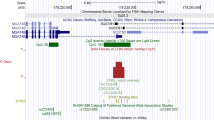Abstract
C15orf2 (Chromosome 15 open reading frame 2) is an intronless gene, which is located in the Prader–Willi syndrome (PWS) chromosomal region on human chromosome 15. Mice do not have an orthologous gene. Here we show that expression of C15orf2 in the fetal human brain is imprinted. Using Western blot and immunohistological studies we have obtained evidence that C15orf2 protein is present in several regions of the brain. Previously published phylogenetic studies as well as population genetic studies based on complex haplotypes as described here suggest that C15orf2 is under positive Darwinian selection. These results indicate that C15orf2 might have an important role in human biology and that a deficiency of C15orf2 might contribute to PWS.





Similar content being viewed by others
References
Farber C, Gross S, Neesen J, Buiting K, Horsthemke B (2000) Identification of a testis-specific gene (C15orf2) in the Prader-Willi syndrome region on chromosome 15. Genomics 65:174–183
Buiting K, Nazlican H, Galetzka D, Wawrzik M, Gross S, Horsthemke B (2007) C15orf2 and a novel noncoding transcript from the Prader-Willi/Angelman syndrome region show monoallelic expression in fetal brain. Genomics 89:588–595
Nielsen R, Bustamante C, Clark AG, Glanowski S, Sackton TB, Hubisz MJ, Fledel-Alon A, Tanenbaum DM, Civello D, Sninsky J, Adams MD, Cargill M (2005) A scan for positively selected genes in the genomes of humans and chimpanzees. PLoS Biol 3:e170
Kosiol C, Vinar T, da Fonseca RR, Hubisz MJ, Bustamante CD, Nielsen R, Siepel A (2008) Patterns of positive selection in six Mammalian genomes. PLoS Genet 4:e1000144
Voight BF, Kudaravalli S, Wen X, Pritchard JK (2006) A map of recent positive selection in the human genome. PLoS Biol 4:e72
Williamson SH, Hubisz MJ, Clark AG, Payseur BA, Bustamante CD, Nielsen R (2007) Localizing recent adaptive evolution in the human genome. PLoS Genet 3:e90
Wawrzik M, Spiess AN, Herrmann R, Buiting K, Horsthemke B (2009) Expression of SNURF-SNRPN upstream transcripts and epigenetic regulatory genes during human spermatogenesis. Eur J Hum Genet 7(11):1463–1470
Zogel C, Bohringer S, Gross S, Varon R, Buiting K, Horsthemke B (2006) Identification of cis- and trans-acting factors possibly modifying the risk of epimutations on chromosome 15. Eur J Hum Genet 14:752–758
Swaab DF (1997) Prader-Willi syndrome and the hypothalamus. Acta Paediatr Suppl 423:50–54
Sahoo T, del Gaudio D, German JR, Shinawi M, Peters SU, Person RE, Garnica A, Cheung SW, Beaudet AL (2008) Prader-Willi phenotype caused by paternal deficiency for the HBII-85 C/D box small nucleolar RNA cluster. Nat Genet 40:719–721
de Smith AJ, Purmann C, Walters RG, Ellis RJ, Holder SE, Van Haelst MM, Brady AF, Fairbrother UL, Dattani M, Keogh JM, Henning E, Yeo GS, O'Rahilly S, Froguel P, Farooqi IS, Blakemore AI (2009) A deletion of the HBII-85 class of small nucleolar RNAs (snoRNAs) is associated with hyperphagia, obesity and hypogonadism. Hum Mol Genet 18:3257–3265
Kruijver FP, Balesar R, Espila AM, Unmehopa UA, Swaab DF (2003) Estrogen-receptor-beta distribution in the human hypothalamus: similarities and differences with ER alpha distribution. J Comp Neurol 466:251–277
Nachman MW, Crowell SL (2000) Estimate of the mutation rate per nucleotide in humans. Genetics 156:297–304
Weber JL, Wong C (1993) Mutation of human short tandem repeats. Hum Mol Genet 2:1123–1128
Acknowledgments
We would like to thank Christina Lich for expert technical assistance and the Deutsche Forschungsgesellschaft for financial support
Author information
Authors and Affiliations
Corresponding author
Rights and permissions
About this article
Cite this article
Wawrzik, M., Unmehopa, U.A., Swaab, D.F. et al. The C15orf2 gene in the Prader–Willi syndrome region is subject to genomic imprinting and positive selection. Neurogenetics 11, 153–161 (2010). https://doi.org/10.1007/s10048-009-0231-z
Received:
Accepted:
Published:
Issue Date:
DOI: https://doi.org/10.1007/s10048-009-0231-z




